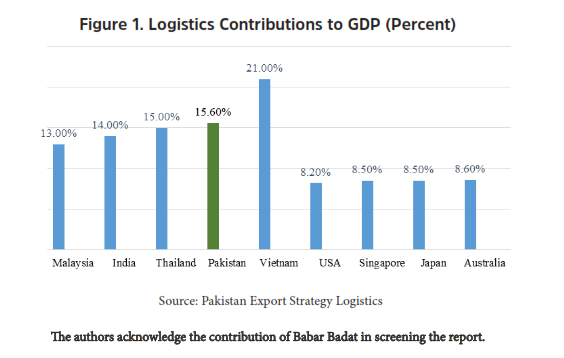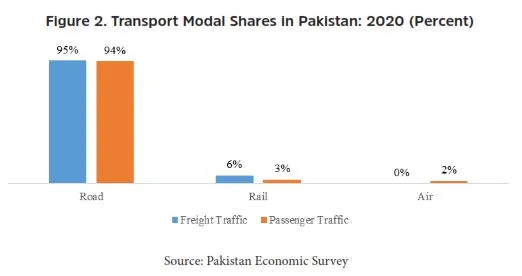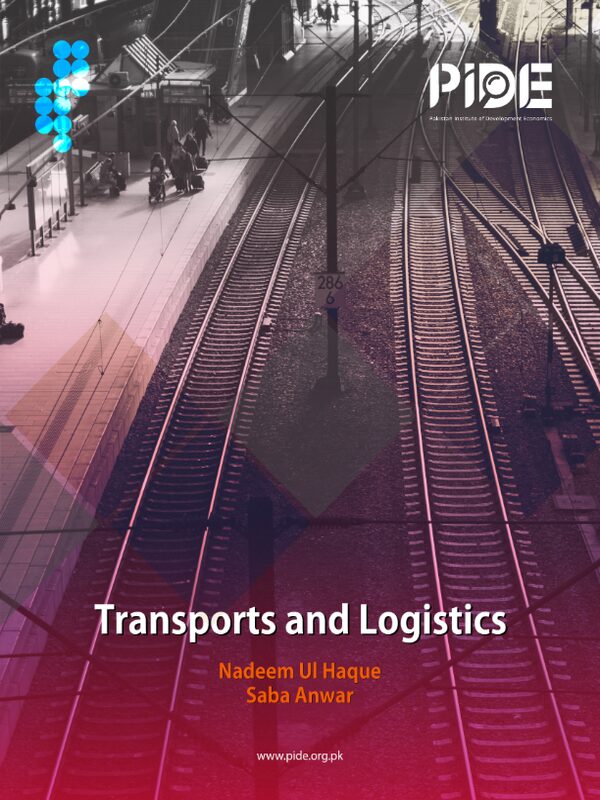Transports and Logistics
KEY MESSAGES
- The estimated potential of Pakistan’s logistics sector is USD 30.7 billion but it has not been realized as yet. Where is it today?
- Pakistan is nowhere in the global scenario according to the recent Logistics Performance Index prepared by the World Bank 2023.
- The modal shares are highly skewed towards roads accounting for more than 92% of passengers and 96% of freight. On average this should be 60%.
- The motorways and highways constitute less than 10% of the total road network but carry almost the entire freight traffic.
- The inadequacy and inefficiency of the public transport system in Islamabad bring more private vehicles on the roads.
- Heavy losses in the railway sector have necessitated an increase in grants from PKR 45 billion in 2022-23 to PKR 55 in 2023-24. Per-passenger grants amount to PKR 1,261 and PKR 5,556 per ton for freight in 2021-22.
- Pakistan Railways has so far failed to adopt the open access policy approved in 2011, which reflects bureaucratic hurdles and governance failures.
- PIDE survey reveals that freight forwarders do not use Pakistan Railways because of the non-availability of relevant information, but mainly because of the non-reliability of the services.
- Pakistan Post has 10,293 post offices in Pakistan, of which 87% are incurring losses, while TCS has a market share of 43% with less than 10% of branches than Pakistan Post.
- The labour unions in public sector organizations have played a major role in resisting reforms, ensuring inefficiencies and substantial losses to the exchequer.
- INTRODUCTION
The transport and logistics infrastructure plays a critical role in domestic commerce in facilitating buying and selling. In fact, transport infrastructure is the asset that increases the productivity of other players in the ecosystem like trucks (Baldwin & Dixon, 2008).
The estimated potential of the logistics sector in Pakistan is USD 30.7 billion (World Bank, 2015), however, this has not been realized due to the sector suffering from several challenges. Pakistan was ranked 122 out of 160 countries in the Logistics Performance Index (LPI) 2018, while disappeared from the international scenario in the 2023 LPI. This calls for immediate attention to the sector that faces several challenges, which must be addressed if it is to compete in the global economy, especially in the region where other countries are performing much better.


In Pakistan, the modal shares are highly skewed towards roads. Roads are the predominant source of transportation in Pakistan accounting for more than 92% of passengers and 96% of freight. This imbalance has increased the cost of transportation through congestion, pollution, and expenditure on the maintenance of roads. In contrast, although the share of rail in both freight and passenger traffic in India is declining (Figure 10.3), it is greater than in Pakistan.


The National Freight and Logistics Policy (2021) document has rightly pointed out that the logistics sector is fragmented and in need of modernization. A lack of institutional framework has further impeded the growth of the logistics sector and a mixture of old and new laws govern what is supposed to be a sector operating in the modern world. The main obstacle lies in the absence of a unified Ministry/Department of Transport responsible for creating and executing a comprehensive National Transport Policy (Shaikh, 2019). Currently, the logistics sector is divided among multiple federal ministries, making it extremely difficult to establish coherent regulations for the sector’s growth and integration.
- The Ministry of Commerce handles foreign and transit trade
- Shipping services are overseen by the Ministry of Ports and Shipping
- The Ministry of Defence is responsible for airports and aviation
- The Ministries of Communications and Railways manage rail and road infrastructure as well as freight
- Customs and cargo clearance affairs fall under the jurisdiction of the Ministries of Finance and Interior
This fragmented structure prevents the effective implementation of existing important regulations like the Trucking Modernization Plan and the National Transport Policy, which were approved in 2007. Consequently, Pakistan has not ratified or adopted international standards and conventions concerning the transportation of goods and products, intensifying the challenges faced by the sector. Furthermore, the sludge (Haque et al, 2022) in the sector which includes burdensome documentation requirements and customs procedures, results in delays, escalates shipment costs, and reduces the ease of doing business in the country.




